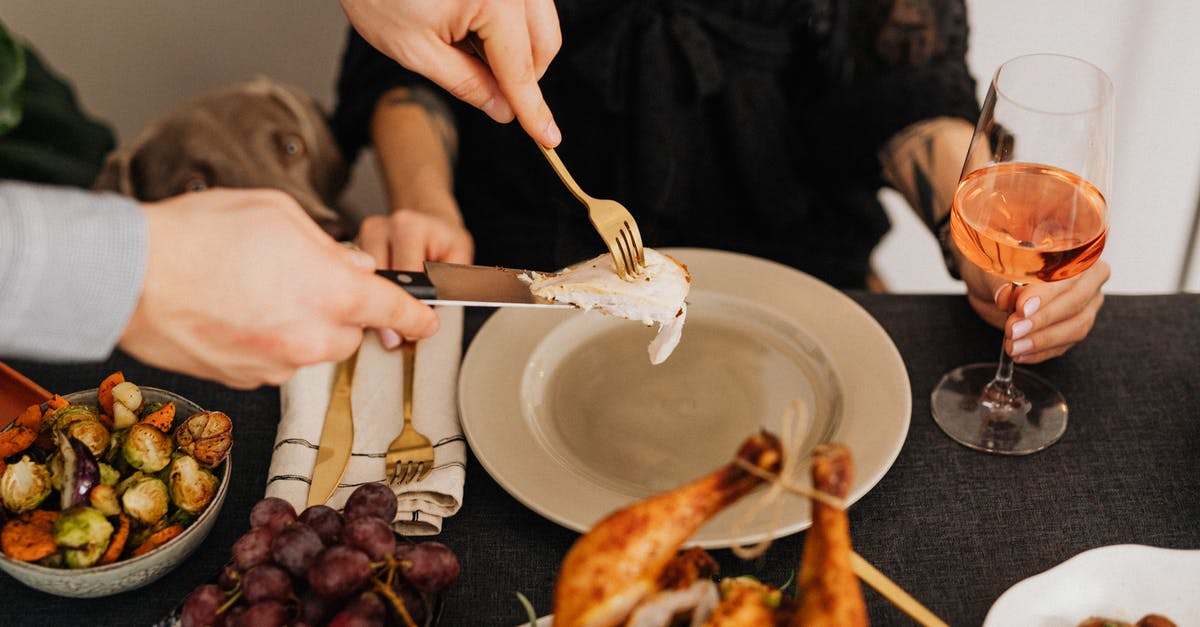How to quickly and safely defrost chicken?

What is the safest, quick way to defrost chicken? Microwave? Running water over it?
Best Answer
I suppose that depends on what you're defrosting it for.
The microwave (on low power) is safe and quick. The downside is that you're using a microwave, which means there's a good chance you'll actually cook the outside slightly in the process, and you're killing enzymes that are normally part of the flavour. The lower the heat, the less the impact of this, but it's still a problem. If I'm preparing the meat for marinating, stir-fry, etc., something with a powerful or thick sauce, then I wouldn't worry about it, but if it's going onto a grill with just a little bit of seasoning, you might want to avoid this.
Running it under warm water would seem to work, but I've found that it takes forever to defrost this way (the exterior will loosen up but the interior stays stubbornly frozen), and you're soaking it in the process. This really isn't suitable if you need to pound or fold the meat or do anything complicated with it.
I would use the microwave if desperate, but it's really best to thaw the meat in the refrigerator or, if you're in a bit of a hurry, the sink. It takes longer, but it'll turn out much better than the microwave in terms of flavour and tenderness.
P.S. One other word of advice: If you're making a dish that requires the chicken to be cut or sliced, it's best not to defrost it all the way. It's easier to cut when frozen, and will defrost very quickly once it's in pieces. I'm mainly talking about the breast here, this doesn't work so well with meat stuck to bones.
Update: I'm noticing a lot of recent hubbub about the dangers of defrosting in the sink / on the countertop or using warm water and I wanted to clarify something. Please note that that the advice above applies to chicken that will be immediately cooked after defrosting and that the defrosting is done over a period shorter than 2 hours.
Raw chicken must not be kept at any temperature above 40° F (4.4° C) for more than an hour or so. Do not defrost a chicken breast in the sink and then toss it back in the fridge. Definitely don't try to defrost a whole bird this way - stick to the refrigerator or very cold running water.
As long as you follow the above precautions and cook the chicken thoroughly (up to an internal temperature of 165° F), you're not in any serious danger of salmonella poisoning, even if the original piece of meat was contaminated - and most chicken sold today is contaminated, for the record.
If the meat is going back in the refrigerator for marinating or you plan to delay cooking for any other reason, then you need to either thaw it very fast (using the microwave) or at a very low temperature (using the refrigerator or cold running water).
Pictures about "How to quickly and safely defrost chicken?"



Quick Answer about "How to quickly and safely defrost chicken?"
How do you safely defrost chicken?
How to safely defrost chickenIs it OK to defrost chicken in water?
Do NOT defrost chicken in hot water! It's not safe. Besides possibly causing bacteria to form, warm water will also start to \u201ccook\u201d the outside of the meat before the middle is thawed).More answers regarding how to quickly and safely defrost chicken?
Answer 2
A microwave is fine for pieces of chicken, particularly it's a newer one which automatically sets the time for you based on the weight of the chicken pieces. (and don't stop just 'cause you think you're done ... that frozen core in the breast won't cook and might ruin your dish.
For whole birds, I go with the running water method -- mostly because my microwave won't fit a whole bird. You want to use cold water for safety, so you don't warm up the poultry too much to make it unsafe. You can put it in a container so there's better contact with the chicken, but you'll want to change it out every few minutes, as the chicken will leech heat from the water (which is what we want).
Answer 3
If you're defrosting in a microwave, put the chicken in a semi-enclosed package (lid on but not sealed shut), this way the steam will help to defrost: Use Low Power or it will cook!!
Answer 4
Screw the microwave. The only thing it's useful for is crappy frozen food and hot water for tea (and even for tea an electric kettle is better).
What you want to do is put your chicken parts in a zip-lock bag if they're not already packaged, and drop that in a container that will hold it. Place said container under a slow-running tap of cold or lukewarm (NOT HOT) water. Depending on the size of the piece(s) you'll have thoroughly defrosted chicken in under an hour, well within the safety zone.
Convection is your friend.
-><-
Answer 5
Using a microwave is probably the quickest way, but you must make absolutely sure the bird is defrosted. Every microwave is different, so check the guide that came with yours for timings. Even then, once you believe it to be defrosted, check the inside of the cavity for ice crystals.
If possible, rest for 10 minutes at room temperature before starting the preparation process. Once defrosted, don't refrigerate.
Answer 6
I usually fill a pot with hot water from the sink and drop the chicken in there (assuming it is vacuum sealed or in a tightly sealed ziplock bag with as much air as possible removed). This seems to work relatively quickly.
This works nicely for just about anything, as long as it's sealed.
Answer 7
A simple way to defrost meat in a relatively short amount of time is to place the meat in a zip-locked baggie and submerge in a large bowl or sink full of slightly cool water. It isn't as quick as a microwave, of course, but it is faster and safer than just leaving out on a counter top. Speed up the process by using warmer water.
Answer 8
Never ever use hot or warm water! That will have a much greater chance of having bacteria. Always use cold or cool water. I myself run it under cold water in my sink continuously while in a tight package instead of submerging it.
Answer 9
The safest way to defrost a chicken is to take it out of the freezer at least two days before and let it defrost naturally while refrigerated. The second way I use is to put the chicken in a microwave safe bowl, fill with water and then follow oven suggestions on time per pound. If you use the water/microwave method it does not cook any parts of the chicken and turning is not necessary. But I definitely take it out of the plastic wrap.
Answer 10
Depends what you are doing with it. From time to time I buy raw stuffed frozen chicken breast. It specifies not thawing, not microwaving. Straight out of the freezer and into the (conventional) oven, cook until safe interior temperature reached (they include a time/temperature guide since the product is of a consistent weight/size which might not apply for a random chunk of frozen chicken.)
It works.
Answer 11
I always buy organic chicken from a registered organic local farm.
I put the chicken in a large tie-handle plastic bag and remove the air before tying a very tight knot so no water can enter or leave the bag. Then I leave the chicken in a large container of cold water if I need it soon rather than later. If you can chop it into smaller pieces this hurries things along.
If I have time, however, I prefer to put the bag in a bowl in the fridge for at least 24 hours to defrost.
Sources: Stack Exchange - This article follows the attribution requirements of Stack Exchange and is licensed under CC BY-SA 3.0.
Images: Karolina Grabowska, Karolina Grabowska, Karolina Grabowska, Karolina Grabowska
